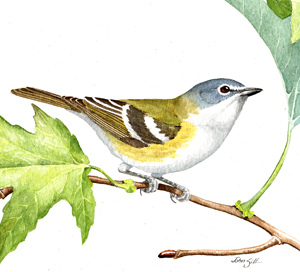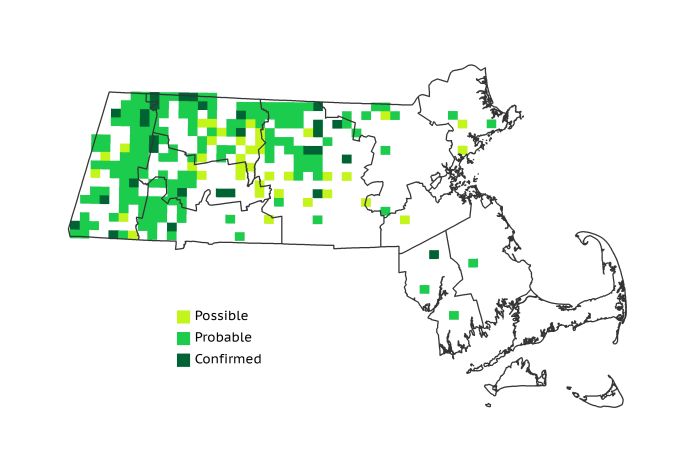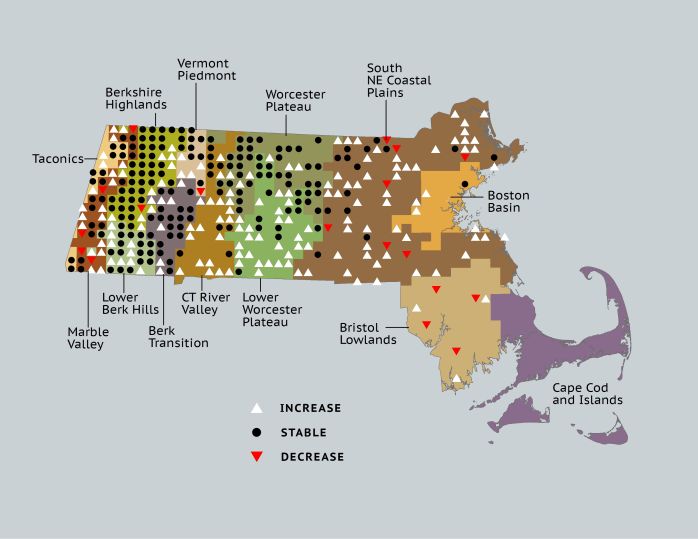Find a Bird
Blue-headed Vireo
Vireo solitarius

Fairly widespread and likely increasing
“To all, ‘The music of the Solitary Vireo is delicious.’” – Birds and Nature magazine, February 1902
The Blue-headed Vireo has only relatively recently been recognized as a distinct species; this bird and two other “new” species were collectively known as the Solitary Vireo until 1997. True to their former appellation, Blue-headed Vireos dwell in the solitude of shady, mature mixed forests with a strong conifer component. Like the Yellow-throated Vireo, this species has exhibited considerable population fluctuations in Massachusetts over the past few centuries. Currently, Blue-headed Vireos seem to be finding the Massachusetts of the twenty-first century to be well suited to their needs.
Historic Status
Historically, the Solitary Vireo was especially well named. Breeding records of the species were rare in the nineteenth century, mostly because the bird preferred haunts where few people tread – the highest elevations in the western part of the state (Howe & Allen 1901). The bird could also be found in the eastern parts of the state, as noted by bird observers such as Bradford Torrey of Weymouth and Edward Howe Forbush, who described listening to one sing while visiting William Brewster in Concord on one occasion (Forbush 1929). Such occurrences in eastern Massachusetts, though, became less common after the Hurricane of 1938, which destroyed essential stands of White Pines across the region.
Atlas 1 Distribution
The breeding presence of Blue-headed Vireos during Atlas 1 was associated, as always, with mature, fairly high elevation mixed forests. As a result, their distribution was heavily skewed toward the western half of the state. The Berkshire Highlands had vireos in 75% of the region, with lower but still considerable concentrations in the surrounding regions. By contrast, the Connecticut River Valley had less than 20% of blocks with Blue-headed Vireos, but in the Worcester Plateau the birds were found breeding in more than half the region. Through the Lower Worcester Plateau and eastward, breeding records were much sparser. The northwestern Coastal Plains contained a fair concentration of occupied blocks, though the Bristol/Narragansett Lowlands showed only four. No breeding Blue-headed Vireos were reported from the Cape and Islands.
Atlas 2 Distribution and Change
The Massachusetts distribution of breeding Blue-headed Vireos was generally expanding at the time of Atlas 2. All western regions exhibited at least a small increase in the number of occupied blocks, especially the Lower Berkshire Hills, Berkshire Highlands, and the Marble Valleys. The Connecticut River Valley experienced striking expansion, and the species’ presence in the Lower Worcester Plateau more than doubled. While Blue-headed Vireos were still somewhat local in the Coastal Plains, they nonetheless quadrupled their number of occupied blocks overall in the period following Atlas 1. The Boston Basin had a handful of reports, and the Bristol/Narragansett Lowlands were the only region to report a net loss of Blue-headed Vireos (albeit a very small one, from 4 blocks to 3). Likely because of their preference for mature mixed forest, Blue-headed Vireos remained absent from Cape Cod.
Atlas 1 Map

Atlas 2 Map

Atlas Change Map

Ecoregion Data
Atlas 1 | Atlas 2 | Change | ||||||
Ecoregion | # Blocks | % Blocks | % of Range | # Blocks | % Blocks | % of Range | Change in # Blocks | Change in % Blocks |
Taconic Mountains | 9 | 56.3 | 3.9 | 19 | 76.0 | 4.2 | 3 | 20.0 |
Marble Valleys/Housatonic Valley | 19 | 48.7 | 8.3 | 28 | 71.8 | 6.2 | 9 | 23.1 |
Berkshire Highlands | 41 | 74.5 | 18.0 | 54 | 98.2 | 12.0 | 11 | 20.8 |
Lower Berkshire Hills | 18 | 64.3 | 7.9 | 30 | 96.8 | 6.7 | 10 | 37.0 |
Vermont Piedmont | 11 | 64.7 | 4.8 | 16 | 94.1 | 3.5 | 3 | 25.0 |
Berkshire Transition | 23 | 60.5 | 10.1 | 35 | 87.5 | 7.8 | 8 | 25.8 |
Connecticut River Valley | 11 | 19.6 | 4.8 | 33 | 50.8 | 7.3 | 17 | 35.4 |
Worcester Plateau | 48 | 61.5 | 21.1 | 85 | 96.6 | 18.8 | 13 | 27.1 |
Lower Worcester Plateau | 22 | 29.7 | 9.6 | 57 | 71.3 | 12.6 | 24 | 44.4 |
S. New England Coastal Plains and Hills | 21 | 7.8 | 9.2 | 86 | 30.4 | 19.1 | 43 | 19.0 |
Boston Basin | 1 | 1.8 | 0.4 | 5 | 8.9 | 1.1 | 4 | 7.3 |
Bristol and Narragansett Lowlands | 4 | 3.8 | 1.8 | 3 | 2.6 | 0.7 | -1 | -1.0 |
Cape Cod and Islands | 0 | 0.0 | 0.0 | 0 | 0.0 | 0.0 | 0 | 0.0 |
Statewide Total | 228 | 23.5 | 100.0 | 451 | 43.5 | 100.0 | 144 | 17.4 |
Notes
In accordance with Atlas increases, the Blue-headed Vireo shows a significant increasing Breeding Bird Survey trend in Massachusetts and in the Eastern US overall.



